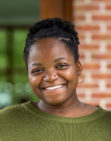My research at the Osun-Osogbo Sacred Grove is focused on the ways in which people of different religious backgrounds collaborate in a space considered to be of environmental, religious, and cultural value. As one of two UNESCO World Heritage sites located in Nigeria, the Osun-Osogbo Sacred Grove is considered to be of “outstanding universal value” in that it houses native tree species and plants used for medicinal purposes and acts as a public religious site for practitioners of Yoruba Indigenous religion where they come to worship the river goddess Osun. The grove, while attractive to foreign organizations like UNESCO, is considered taboo due to its relationship to the marginalized indigenous religion, which is understood as backwards and is one often demonized by Christians and Muslims alike. That said, the grove’s status as a world heritage site and a national monument has granted it protection by the federal and state government through organizations like National Commission for Museums and Monuments (NCMM). The NCMM branch located in Osogbo, Nigeria, oversees the protection of the grove through its administrative staff responsible for its upkeep. Most of these staff members are often either Muslims or Christians who work together with practitioners of the Yoruba Indigenous religion in grove maintenance.
In trying to understand what motivated religious collaboration at the grove, I spent this past summer volunteering at the grove and engaging with both practitioners of Yoruba Indigenous religion and administrative staff members, to investigate membership in this organization from different religious perspectives. I was especially interested in the annual Osun-Osogbo festival at the grove that attracted non-affiliated locals and practitioners of the Yoruba Indigenous religion from all over the world, including Brazil, the Dominican Republic, and different parts of Asia. This festival represented a moment in which cooperation and investment in the sacred grove was not just between administrative staff members and practitioners who normally used and took care of the grove, but also between locals who otherwise stay away from the grove. I observed interactions and conducted interviews with participants in order to better understand how various groups came together at this particular site.
Additional Reading
Greene, Sandra E. Sacred Sites and the Colonial Encounter: A History of Meaning and Memory in Ghana. Bloomington: Indiana University Press, 2002.
Ogundiran, Akinwumi. “The Osun-Osogbo Grove as a Social Common and an Uncommon Ground: An Analysis of Patrimonial Patronage in Postcolonial Nigeria.” International Journal of Cultural Property 21, no. 02 (May 2014): 173–98.
Ogundiran, Akinwumi. “A Multiplex Landscape: Explorations of Place and Practice in Osun-Grove, Nigeria.” In Cultural Landscape Heritage in Sub-Saharan Africa, edited by John Beardsley and Dumbarton Oaks. Washington, D.C: Dumbarton Oaks Research Library and Collection, 2016.
Olupona, Jacob K. “Orisa Osun: Yoruba Sacred Kinghip and Civil Religion in Osogbo, Nigeria.” In Ọ̀ṣun across the Waters: A Yoruba Goddess in Africa and the Americas, edited by Joseph M. Murphy and Mei-Mei Sanford. Bloomington: Indiana University Press, 2001.
Sheridan, Michael J., and Celia Nyamweru, eds. African Sacred Groves: Ecological Dynamics & Social Change. Oxford: Athens, OH : Pretoria: James Currey ; Ohio University Press ; Unisa Press, 2008.
Additional Credits
Special thanks to the National Commission for Museum and Monuments-Osogbo, Curator, Fatai Adekunle, NCMM-Osogbo Research Unit, Osun-Osogbo Sacred Grove, Osun Devotees, and the Religion, Race & Democracy Lab,
Get Involved
Learn about forthcoming podcast episodes, newly published projects, research opportunities, public events, and more.
Potential Students


